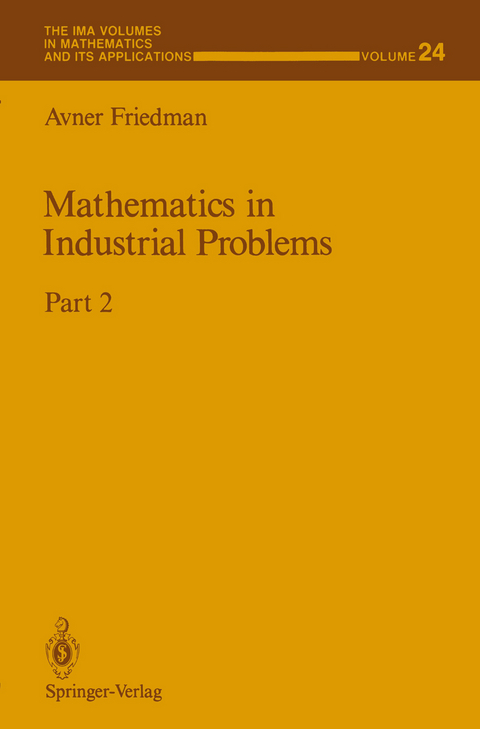
Mathematics in Industrial Problems
Springer-Verlag New York Inc.
978-1-4615-7404-0 (ISBN)
This is the second volume in the series "Mathematics in Industrial Prob lems." The motivation for both volumes is to foster inter action between Industry and Mathematics at the "grass roots"; that is at the level of spe cific problems. These problems come from Industry: they arise from models developed by the industrial scientists in venture directed at the manufac ture of new or improved products. At the same time, these problems have the potential for mathematical challenge and novelty. To identify such problems, I have visited industries and had discussions with their scientists. Some of the scientists have subsequently presented their problems in the IMA seminar on Industrial Problems. The book is based on questions raised in the seminar and subsequent discussions. Each chapter is devoted to one of the talks and is self-contained. The chap ters usually provide references to the mathematical literat ure and a list of open problems which are of interest to the industrial scientists. For some problems partial solution is indicated brießy. The last chapter of the book contains a short description of solutions to some of the problems raised in the first volume, as weIl as references to papers in which such solutions have been published. The experience of the last two years demonstrates a growing fruitful interaction between Industry and Mathematics. This interaction benefits Industry by increasing the mathematical knowledge and ideas brought to bear upon its concern, and benefits Mathematics through the infusion of exciting new problems.
1 Signal design problems in multi-channel data communication.- 1.1 General problems.- 1.2 A lower bound on MCT(d).- 1.3 Pulse amplitude modulation (PAM).- 1.4 References.- 2 Solitons in non-homogeneous medium.- 2.1 Optical fiber sensor; linear theory.- 2.2 Fiber optic sensor; nonlinear theory.- 2.3 Known recent results.- 2.4 Back to the open questions.- 2.5 References.- 3 Foam rheology.- 3.1 Equilibrium Structure.- 3.2 Future directions.- 3.3 References.- 4 Applications of large deviations to communications.- 4.1 Examples.- 4.2 Theory of large deviations.- 4.3 Applications.- 4.4 Open problems.- 4.5 References.- 5 Phase modulation in nonlinear optical medium.- 5.1 The model and the problem.- 5.2 Two numerical approaches.- 5.3 The full problem.- 5.4 References.- 6 Multiple solutions in semiconductor device modeling.- 6.1 The basic equations.- 6.2 Ohm’s law.- 6.3 A p — n diode.- 6.4 The p — n — p and n — p — n transistors.- 6.5 Flip-flop and p — n — p — n junction.- 6.6 Open problems.- 6.7 References.- 7 Mathematical models for thermal imaging-an heuristic approach.- 7.1 The problem.- 7.2 Linear diffusion approach.- 7.3 An alternative approach.- 7.4 References.- 8 Graph spectra, connectivity, and spin glass models of associative memory.- 8.1 Evolution of neural network.- 8.2 Spin glasses.- 8.3 Results for neural networks.- 8.4 Open problems.- 8.5 References.- 9 Mathematical problems in electron beam lithography.- 9.1 The lithography steps.- 9.2 Mathematical issues.- 9.3 The proximity equation.- 9.4 Suggestions.- 9.5 References.- 10 A reaction-diffusion model of color negative film development.- 10.1 The development process.- 10.2 Homogenization problems.- 10.3 Edge enhancement.- 10.4 Solution of Problem (1).- 10.5 Solution of Problem (2).- 10.6 Partialsolution to problem (3).- 10.7 References.- 11 An inverse problem arising in the evolution of combustion aerosols.- 11.1 The model.- 11.2 Small coagulation.- 11.3 Partial solutions.- 11.4 References.- 12 Adaptive focused beamforming.- 12.1 The basic equations.- 12.2 The methods of AFB.- 12.3 Future directions.- 12.4 References.- 13 Optimal switching between a pair of Brownian motions.- 13.1 Optimal switching within a class of diffusion processes.- 13.2 Switching a pair of Brownian motions.- 13.3 Open problems.- 13.4 Solution of some of the problems.- 13.5 References.- 14 Mathematical models of latent image formation.- 14.1 The Hamilton-Bayer theory [1].- 14.2 The Monte Carlo Method.- 14.3 An alternate approach.- 14.4 References.- 15 Modeling problems in magneto-optic recording.- 15.1 An outline.- 15.2 Absorption of laser radiation.- 15.3 The heat generation.- 15.4 The magnetic energy effect.- 15.5 References.- 16 Shaped charge jets and subsonic free-surface flow theory.- 16.1 The model.- 16.2 The Chaplygin method.- 16.3 A variational approach.- 16.4 References.- 17 Electrophotographic system models.- 17.1 General description.- 17.2 Mathematical issues.- 17.3 References.- 18 Fluid models and other asymptotic limits with data and teletraffic applications.- 18.1 Asymptotics of closed product-form queueing networks.- 18.2 A fluid approximation.- 18.3 Stochastic fluid models.- 18.4 References.- 19 Solutions to problems from volume 1.- 19.1 References.
| Erscheint lt. Verlag | 9.5.2012 |
|---|---|
| Reihe/Serie | The IMA Volumes in Mathematics and its Applications ; 24 |
| Zusatzinfo | 10 Illustrations, black and white; XII, 183 p. 10 illus. |
| Verlagsort | New York, NY |
| Sprache | englisch |
| Maße | 155 x 235 mm |
| Themenwelt | Mathematik / Informatik ► Informatik ► Theorie / Studium |
| Mathematik / Informatik ► Mathematik ► Analysis | |
| Mathematik / Informatik ► Mathematik ► Angewandte Mathematik | |
| Mathematik / Informatik ► Mathematik ► Finanz- / Wirtschaftsmathematik | |
| Naturwissenschaften ► Physik / Astronomie ► Allgemeines / Lexika | |
| Naturwissenschaften ► Physik / Astronomie ► Optik | |
| Naturwissenschaften ► Physik / Astronomie ► Theoretische Physik | |
| Technik ► Maschinenbau | |
| ISBN-10 | 1-4615-7404-8 / 1461574048 |
| ISBN-13 | 978-1-4615-7404-0 / 9781461574040 |
| Zustand | Neuware |
| Informationen gemäß Produktsicherheitsverordnung (GPSR) | |
| Haben Sie eine Frage zum Produkt? |
aus dem Bereich


